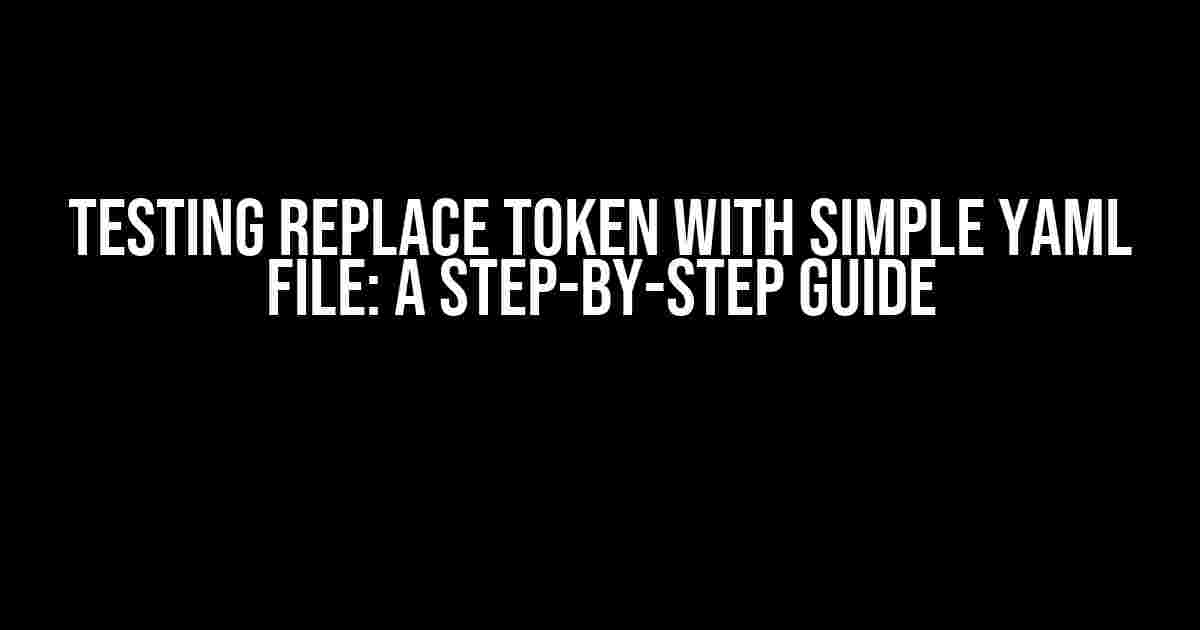Are you tired of manually replacing tokens in your code or configuration files? Do you want to make your testing process more efficient and less prone to errors? Look no further! In this article, we’ll show you how to use a simple YAML file to replace tokens during testing, making your life as a developer easier and more productive.
What is Token Replacement?
Token replacement is a process of replacing placeholders in your code or configuration files with actual values. This technique is commonly used in testing to simulate different environments, users, or scenarios. For example, you might have a token for a database connection string, an API key, or a username. During testing, you can replace these tokens with different values to test different scenarios.
Why Use YAML for Token Replacement?
YAML (YAML Ain’t Markup Language) is a human-readable serialization format that’s widely used in configuration files, data exchange, and testing. YAML files are easy to read and write, making them an ideal choice for storing token values. By using a YAML file for token replacement, you can:
- Store multiple token values in a single file
- Easily switch between different sets of token values
- Version control your token values
- Share token values across different tests or projects
Creating a Simple YAML File for Token Replacement
Let’s create a simple YAML file called `tokens.yaml` with the following contents:
db_connection_string: "localhost:5432"
api_key: "1234567890abcdef"
username: "john.doe"
This YAML file defines three tokens: `db_connection_string`, `api_key`, and `username`. You can add or remove tokens as needed, depending on your testing requirements.
Replacing Tokens using a YAML File
To replace tokens using a YAML file, you’ll need to:
- Read the YAML file
- Parse the YAML file to extract token values
- Replace tokens in your code or configuration files with the extracted values
Here’s an example of how you can do this using Python:
import yaml
with open('tokens.yaml', 'r') as file:
tokens = yaml.safe_load(file)
# Replace tokens in your code or configuration files
config_file = "config.txt"
with open(config_file, 'r+') as file:
content = file.read()
for token, value in tokens.items():
content = content.replace(f"{{{{{token}}}}}", value)
file.seek(0)
file.write(content)
file.truncate()
In this example, we read the `tokens.yaml` file using the `yaml` library, parse the file to extract token values, and then replace tokens in a `config.txt` file using string replacement.
Token Replacement in Different Programming Languages
Token replacement is not limited to Python. You can use YAML files for token replacement in other programming languages, such as:
| Language | Library/Module |
|---|---|
| Java | snakesyaml |
| Python | yaml |
| Ruby | Psych |
| C# | YamlDotNet |
Each language has its own libraries or modules for parsing YAML files and performing token replacement. Research the specific library or module for your language of choice to learn more.
Best Practices for Token Replacement
To get the most out of token replacement, follow these best practices:
- Use descriptive token names to avoid confusion
- Store sensitive information, such as API keys, securely
- Use version control to track changes to your token values
- Document your token values and their usage
- Test your token replacement process thoroughly
Conclusion
Token replacement is a powerful technique for making your testing process more efficient and less prone to errors. By using a simple YAML file to store token values, you can easily switch between different sets of values and reduce the risk of manual errors. Remember to follow best practices for token replacement, and don’t be afraid to explore other libraries and modules for your language of choice.
Happy testing!
Frequently Asked Question
Get answers to your questions about testing replace token with a simple YAML file.
What is the purpose of testing replace token with a simple YAML file?
Testing replace token with a simple YAML file is used to ensure that the token replacement process works correctly and efficiently, allowing you to verify that your application is functioning as expected.
How do I create a simple YAML file for token replacement testing?
To create a simple YAML file, start by creating a new file with a .yaml extension, then add key-value pairs in a formatted structure. For example, you can add tokens as keys and their corresponding values as values.
What are the benefits of using a YAML file for token replacement testing?
Using a YAML file for token replacement testing offers several benefits, including easy setup, flexibility, and simplicity. YAML files are also human-readable, making it easier to understand and maintain test data.
Can I use a YAML file to test token replacement for multiple environments?
Yes, you can use a YAML file to test token replacement for multiple environments by creating separate sections or blocks for each environment, and specifying the corresponding tokens and values for each.
What are some common use cases for token replacement testing with a YAML file?
Common use cases for token replacement testing with a YAML file include testing API endpoint URLs, database connections, and environment variables. It’s also useful for testing microservices and distributed systems.
